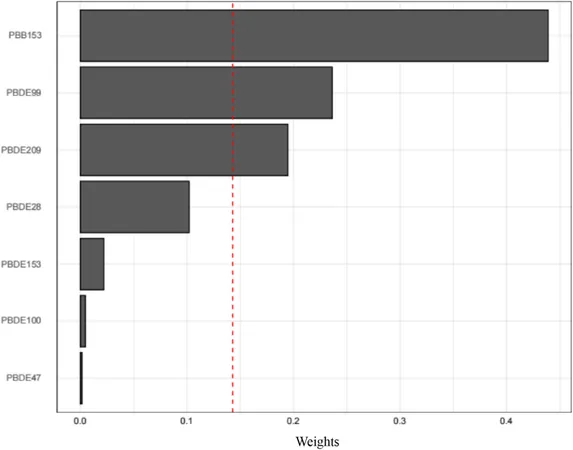
The Alarming Link Between Brominated Flame Retardants and Obstructive Sleep Apnea in U.S. Adults
2025-01-14
Author: Wei Ling
Understanding Brominated Flame Retardants (BFRs)
In an era where synthetic materials dominate our homes and workplaces, the lurking dangers of brominated flame retardants (BFRs) have come into sharper focus. These chemical compounds, widely used in everything from electronics to furniture, are now being scrutinized for their potential health risks — particularly their association with obstructive sleep apnea syndrome (OSAS) among U.S. adults.
Health Risks Associated with BFRs
Brominated flame retardants are synthetic substances integral to enhancing fire safety in various consumer products. However, their accumulation in our environment and bodies raises significant health concerns. Chemicals such as polybrominated diphenyl ethers (PBDEs) and 2,2′,4,4′,5,5′-hexabromobiphenyl (PBB153) are known for their toxicity, persistence, and bioaccumulative nature. Alarmingly, these substances have been detected in human tissues and fluids, including blood, urine, and breast milk, indicating widespread exposure through common products, foods, and air.
The Connection Between BFRs and OSAS
Previous research has established links between BFR exposure and a range of health issues, including neurological disorders and hormonal disruptions. However, the connection between BFRs and sleep disorders — specifically obstructive sleep apnea (OSAS) — has received scant attention until now.
What is Obstructive Sleep Apnea?
OSAS is characterized by repeated episodes of airway obstruction during sleep, leading to disrupted sleep patterns and a host of related health complications. Symptoms include loud snoring, gasping during sleep, and excessive daytime drowsiness, which can lead to serious outcomes like cardiovascular issues and increased mortality. The risk factors for OSAS remain a critical area of public health research, especially given its high prevalence in the general population.
Recent Research Findings
Recent studies utilizing data from the National Health and Nutrition Examination Survey (NHANES) explored the potential dual role of BFRs as a significant risk factor for the development of OSAS. The research highlighted that individuals are often exposed to multiple BFRs simultaneously, raising concerns about their toxicological interactions and cumulative effects.
Key Study Outcomes
In their comprehensive analysis, researchers evaluated data from nearly 10,000 adults and found a troubling correlation between levels of serum BFRs and the risk of OSAS. Using advanced statistical methods, including logistic regression models and weighted quantile sum analysis, the researchers uncovered that higher concentrations of several BFRs, particularly PBB153 and certain PBDEs, were associated with increased odds of developing OSAS. Shockingly, doubling the serum concentration of PBB153 was linked to a 24% increased risk of exhibiting OSAS symptoms.
Impact on Hormonal Balance and Sleep Quality
Moreover, the findings indicated that these chemicals may interfere with the body’s hormonal balances, including disruptions in thyroid function and neurotransmitter systems like dopamine. Such disruptions could exacerbate sleep quality and contribute to the severity of sleep apnea.
Conclusion and Call to Action
While the study sheds light on the neglected relationship between environmental chemical exposure and sleep health, it also opens the door to further exploration of how BFRs impact not just sleep disorders but broader aspects of health.
In a world increasingly reliant on synthetic products, it’s vital to remain aware of the substances permeating our daily lives. The implications of this research demand immediate public health attention, emphasizing the urgent need for stricter regulations regarding BFRs in consumer goods. As the quest for safer alternatives continues, understanding these environmental links is crucial for safeguarding health and improving the quality of life for millions affected by sleep disorders.
Final Thoughts
Don't fall asleep at the wheel! Stay tuned for updates on this developing story and learn how you can protect yourself from hidden dangers lurking in everyday products!






 Brasil (PT)
Brasil (PT)
 Canada (EN)
Canada (EN)
 Chile (ES)
Chile (ES)
 Česko (CS)
Česko (CS)
 대한민국 (KO)
대한민국 (KO)
 España (ES)
España (ES)
 France (FR)
France (FR)
 Hong Kong (EN)
Hong Kong (EN)
 Italia (IT)
Italia (IT)
 日本 (JA)
日本 (JA)
 Magyarország (HU)
Magyarország (HU)
 Norge (NO)
Norge (NO)
 Polska (PL)
Polska (PL)
 Schweiz (DE)
Schweiz (DE)
 Singapore (EN)
Singapore (EN)
 Sverige (SV)
Sverige (SV)
 Suomi (FI)
Suomi (FI)
 Türkiye (TR)
Türkiye (TR)
 الإمارات العربية المتحدة (AR)
الإمارات العربية المتحدة (AR)